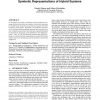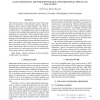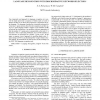1291 search results - page 72 / 259 » Learning a language model from continuous speech |
JMLR
2010
14 years 4 months ago
2010
Continuous-time Bayesian networks is a natural structured representation language for multicomponent stochastic processes that evolve continuously over time. Despite the compact r...
HYBRID
2010
Springer
15 years 4 months ago
2010
Springer
In this paper, we present an extension of the synchronous language Quartz by new kinds of variables, actions and statements for modeling the interaction of synchronous systems wit...
ACL
2010
14 years 8 months ago
2010
English noun/verb (N/V) pairs (contract, cement) have undergone complex patterns of change between 3 stress patterns for several centuries. We describe a longitudinal dataset of N...
ICASSP
2008
IEEE
15 years 4 months ago
2008
IEEE
There has been little work that attempts to improve the recognition of spontaneous, conversational speech by adding information from a loosely-coupled modality. This study investi...
ICASSP
2008
IEEE
15 years 4 months ago
2008
IEEE
One commonly used approach for language recognition is to convert the input speech into a sequence of tokens such as words or phones and then to use these token sequences to deter...



